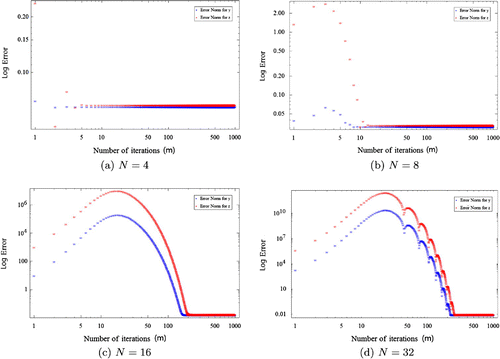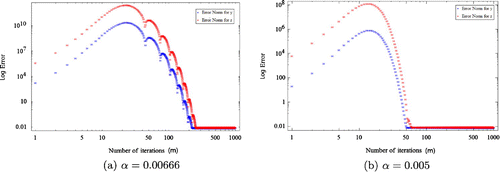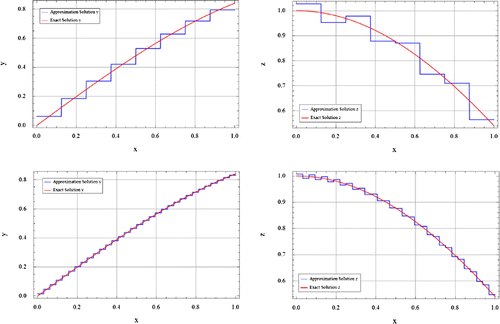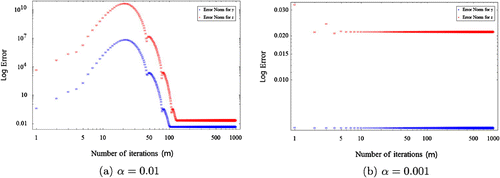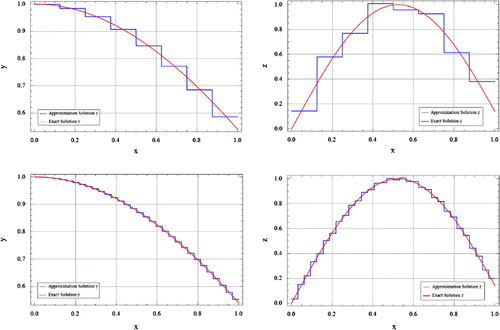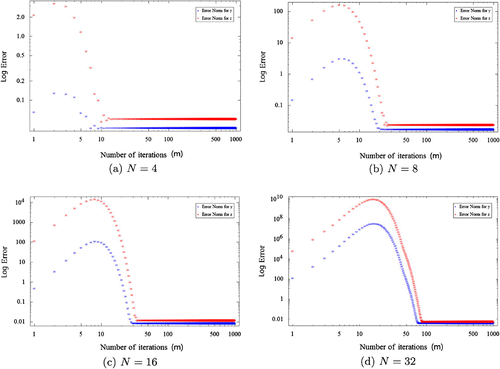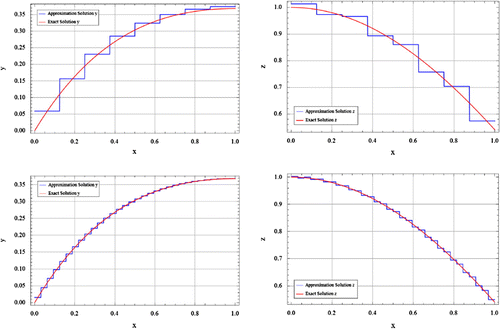 ?Mathematical formulae have been encoded as MathML and are displayed in this HTML version using MathJax in order to improve their display. Uncheck the box to turn MathJax off. This feature requires Javascript. Click on a formula to zoom.
?Mathematical formulae have been encoded as MathML and are displayed in this HTML version using MathJax in order to improve their display. Uncheck the box to turn MathJax off. This feature requires Javascript. Click on a formula to zoom.Abstract
It is known that the coupled system consisting of Volterra integral equations of the first and second kind belongs to the class of moderately ill-posed problems. In the present paper, we are interested in numerical solution of Volterra integral-algebraic equations by a direct regularization method, i.e. an approach which does not make use of the adjoint operator as well as any reduction or remodelling of the original problem. A numerical algorithm based on Lavrentiev’s regularization iterated method is constructed that preserves the Volterra structure of the original problem. The convergence analysis of the proposed method is given and its validity and efficiency are also demonstrated through several numerical experiments.
1. Introduction
This article deals with the numerical solution of general system of Volterra integral equations:(1.1)
(1.1)
where the matrices and the function
are assumed to be continuous on their domains, and the matrix A(t) is singular that is, det
and rank
on
. Following [Citation1], we will refer to this system of Volterra integral equations as Integral-Algebraic Equations (IAEs), due to the terminology introduced by Gear. Generally, such ill-posed systems consist of a coupled system of Volterra integral equations of the first and second kind which may be arise in many applied problems e.g. in memory kernel identification problems in heat conduction [Citation2], viscoelasticity [Citation3], evolution of a chemical reaction within a small cell [Citation4] and Kirchhoff’s laws.
The Volterra IAEs belong to the class of moderately ill-posed problems, since the ill-posedness is not nearly as serious for Volterra equations as it is for the Fredholm case. However, the first kind Volterra equation which appears in the IAE system is sufficiently unstable as to require regularization techniques in order to compute reasonably accurate solutions. The discretization as well as regularization techniques have a regularizing feature with a regularization parameter which is in a certain manner connected to the level of disturbances of the initial data.
The index notion is a critical issue for the theoretical and numerical analysis of an IAE system, which has been first introduced by Gear [Citation1] and has recently extended by Liang and Brunner [Citation5]. It is closely connected to the concept of -smoothing property of a Volterra integral operator which has been defined by Lamm for the case
and extended by Brunner for
. Actually, this is a tool for consideration the ill-posed nature as well as a measure for the degree of ill-posed ness of the first kind Volterra integral equation in the IAE system. Following [Citation6], it is known that for the Volterra IAEs, the degree of instability increases as the degree of
-smoothing increases.
Although, the analysis of IAEs have received less attention, however, in recent years the numerical solvability of IAEs have been pursued by a few researches. In 2000, Kauthen [Citation7] studied polynomial spline collocation method and the convergence results. Hadizadeh et al. [Citation8] in 2011, presented the Jacobi collocation method including the matrix-vector multiplication representation for IAEs of index-2. A posteriori error estimation is also obtained for the Legendre collocation method by the same authors in [Citation9]. These methods extended to the semi-explicit IAEs of indices 1 and 2 as well as the IAEs with weakly singular kernels by Pishbin [Citation10] in 2013. A multistep method based on Adam’s quadrature rules and extrapolation formulas constructed by Bulatov et al. [Citation11]. More recent studies are due to Liang and Brunner [Citation5,Citation12], who have presented an analysis of piecewise polynomial collocation solutions for general systems of linear IAEs based on the notions of the tractability index and the -smoothing property by decoupling the system into the inherent system of regular Volterra integral equations. Actually, most of the numerical methods discussed so far, have been the projection-based approach and according to [Citation12], this approach together with the tractability index are natural ways of analysing the general systems of IAEs. However, owing to some restrictive conditions as well as instability of numerical differentiation, the reduction of the problem to the regular system of Volterra equations may not be always practical from a numerical point of view. Another difficulty is related to high computational complexity of the projection based methods, since the associated projectors onto the nullspaces have to be computed at every integration step, which makes the approach rather expensive. Due to the ill-posed behaviour of the first kind Volterra integral equation in the IAEs, we are seeking for a regularization type method for overcoming the difficulties which may arise in numerical consideration of the problem. Therefore, in the present paper we are interested in certain direct regularization approaches for numerically solving the Volterrs IAEs system i.e. the method which does not make use of an inversion formula or some restrictive conditions for the exact solution and especially which is not based on any reduction procedure for the original problem. Since the most classical regularization methods are based on the inversion of the operator and consequently such methods do not generally preserve the Volterra structure of the original problem, here we pay special attention to applicability of Lavrentiev’s regularization iterated method for the approximate solution of Volterra IAEs system of index-1.
The paper is organized as follows. In Section 2, we give some preliminaries and main results related to general IAE theory and regularization techniques. In Section 3, we describe a direct regularization method based on Lavrentiev’s iterated scheme for IAE system of index-1 and derive an experimental strategy for choosing the optimal value of the regularization parameter. Section 4 deals with the convergence analysis of the method. We end up with some numerical illustrations and report the numerical experiments in Section 5.
2. Preliminaries and IAE theory
In this section, we review some basic facts of IAE theory from [Citation13] and present results on the solvability of an integral-algebraic Equation (Equation1.1(1.1)
(1.1) ), when the kernel is continuous. Throughout this paper, we assume that all linear operators occurring here map on Hilbert space
with the inner product (, ) and norm
. We will also give some preliminary results related to positive (monotone) operators which is needed for our convergence analysis of the method presented in Section 4.
The -smoothing property is a main concept for describing a measure of the degree of ill-posedness of the first kind Volterra operator,
,
This concept defined by Lamm [Citation14] and has been recently extended to the higher case () by Liang and Brunner [Citation5]:
Definition 2.1:
[From [Citation5])]The Volterra integral operator T corresponding to the kernel matrix , with
said to be
-smoothing, if there exist integers
with
such that the following hold:
| (a) | |||||
| (b) |
| ||||
| (c) | |||||
A first kind Volterra equation , is called a
-smoothing problem, if T is a
-smoothing operator and
Accordingly, a one-smoothing problem () is the least ill-posed, since it requires only one differentiation operation.
In order to review some basic concepts related to IAE theory, let us consider the following semi-explicit linear version of (Equation1.1(1.1)
(1.1) ):
(2.1)
(2.1)
The following theorem describes the conditions under which the Equation (Equation2.1(2.1)
(2.1) ) possesses a unique continuous solution:
Theorem 2.2:
[From [Citation13])]Let and assume that:
| (1) |
| ||||
| (2) |
| ||||
| (3) |
| ||||
The concept of index has been introduced in order to quantify the level of difficulty that is involved in solving a given IAEs. There are several different (but often closely related) definitions of the index for an IAE which reveal the mathematical structure, stability and solvability in the analysis of the IAEs. At first, we recall the definition of differential index of IAEs which is due to Gear [Citation1]:
Definition 2.3:
We say the system (Equation2.1(2.1)
(2.1) ) has differential index m, if m is the minimum possible number of differentiating (Equation2.1
(2.1)
(2.1) ) to obtain a system of second kind Volterra equations.
As shown in [Citation5], the kernel function seriously impacts on the solution as well as the differential index and the tractability index. For this reason, Brunner [Citation13] has defined the tractable index as follows:
Definition 2.4:
[From [Citation13]] The semi-explicit IAE (Equation2.1(2.1)
(2.1) ) is said to be index-1 tractable, if the first kind VIE
is uniquely solvable in whenever
and
.
Another concept that needs to be introduced is the positivity (monotonicity) of an operator which is discussed in detail in [Citation15] and here we give an explanation of this issue without lengthy and detailed hypothesis:
Definition 2.5:
A bounded self-adjoint linear operator T in Hilbert space is said to be positive (monotone), written , if and only if
, for each u .
As indicated in [Citation15], the positive or monotone operators coincide with sectorial operators, and some references refer them as accretive operators which satisfy , or equivalently the resolvent set
corresponding to
contains
and
where is a constant. (cf. [Citation16, Chapter2]).
In the next section, we will present a direct algorithm based on an iterative regularization method for the approximate solution of Volterra system of IAEs of index-1.
3. Regularization for integral-algebraic equations of index-1
Let us consider the linear system of IAEs (Equation1.1(1.1)
(1.1) ), where
is a singular matrix,
and
such that the data functions
and
are sufficiently smooth and
with
satisfies
It will often be useful to rewrite the Equation (Equation1.1(1.1)
(1.1) ) in the compact form
(3.1)
(3.1)
where the operator is defined by
with , such that
is an identity operator and the Volterra integral operators
are given by
Due to non-degeneracy of the kernels , Equation (Equation1.1
(1.1)
(1.1) ) is ill-posed. Therefore, in the case of perturbed data, we are concerned to
instead of g; where
satisfies
for some
.
For describing our direct approach, we give firstly some results regarding the Lavrentiev’s m-times iterated method which is followed directly from [Citation14]:
For fixed integer , and given regularization parameter
, the Lavrentiev’s m-times iterated method for equation
, determines
via
(3.2)
(3.2)
starting from . For
, the method reduces to Lavrentiev’s classical method, meanwhile for
, corrections are applied to further stabilize the problem. (see e.g. [Citation14,Citation17,Citation18] for further details). As, any iterative regularization methods must address several principles e.g. concerning the initial values, the regularization parameter, stopping criterion and convergence properties, we have to show the reasons why the proposed method is a suitable procedure. Note that, typical discretization of the problem leads to a sparse matrix representation which means that the calculation of
with an iterated method will be accomplished rather fast. These matrices have very small entries along the diagonals, and thus one way to stabilize such a system would be to augment the values on the diagonal, so adding a term
(for
small) serves to stabilize the numerical process. We refrain from going into more details and refer the reader to [Citation19–Citation21] for further issues.
A perturbed version of system (Equation3.1(3.1)
(3.1) ) may be considered as follows:
which is a (well-posed) second kind Volterra system and has a unique solution depending continuously on data. For numerical implementation of the method, we approximate X(t) in terms of its components and
in the form
, where
are basis functions and
,
will be determined through the vector
which is obtained by the following iterative algorithm:
such that
For choosing the parameter , we may start from
and for fixed m with g replaced by
and
, for some
, we will use a multi-step process to find the appropriate
. To do so, let r be the number of steps so that in each step we have m iteration, and let
denotes the defect in each step i.e.
where . Now, for fixed b , we choose some
, ( here
, due to a given integer r as a number of steps), and set
. The process of computing
can be stopped, whilst
and then, set , where
denotes the stopping index.
Under this terminology, for rather small number of iterations m and divisions N , a suitable is available which gives us an appropriate approximate solution. However, for improving the solution, a good strategy is to proceed the method iteratively with obtained
, until the more appropriate solution is attained. This issue will be further discussed experimentally in Section 5 which shows the low computational complexity of the proposed method respect to the other projection based methods.
4. Convergence analysis
Our convergence analysis is mainly based on properties of monotone operators that we have mentioned in Section 2. These operators are one of the most important and particular cases for investigating the application and theoretical analysis of the Lavrentiev’s method. We refrain from going into details and pointed out the analysis of Lavrentiev’s m-times iterated method for Volterra integral equations with monotone operators can be found in [Citation15,Citation22,Citation23] and references therein.
This useful lemma which is due to [Citation24], shows that the usual operator norm holds for general operator matrices, here
:
Lemma 4.1:
[From [Citation24])] If A, B, C and D are operators in B(H) which denotes the space of all bounded linear operators on a complex separable Hilbert space H with the usual operator norm , which is defined on all of B(H), then
We are now ready to state the main result on the convergence analysis of the presented method applied to integral-algebraic equations of index-1:
Theorem 4.2:
Consider the operator matrix and let
be continuous for
, where
be a closed, bounded set in
. Assume that the Integral-Algebraic Equation (Equation3.1
(3.1)
(3.1) ) is uniquely solvable for given
. Let an appropriate regularization parameter
be chosen such that
and
, as
. Moreover, the linear and bounded operator
is such that
(4.1)
(4.1)
where the norm of operator matrix
is defined by
Then, for , the approximate solution of the proposed method satisfies
, where
is the exact solution.
Proof The proof is presented in two parts. Let us first consider the case for the exact data.
We replace the Equation (Equation3.1(3.1)
(3.1) ) in Lavrentiev regularization by the linear system of equations
, and rewrite the Lavrentiev’s iteration
in terms of
as
or
Subtracting from X , obtains
(4.2)
(4.2)
This is true for any value of n , so we can write(4.3)
(4.3)
substituting (Equation4.3(4.3)
(4.3) ) into (Equation4.2
(4.2)
(4.2) ), leads to
Continuing this process n times, the following equation is obtained
this shows that converges to the solution X , if and only if
as
.
Taking as an arbitrary choice of the initial approximation, the sequence
can be generated in the following iterative relation
Due to the monotonicity property of the operator , it follows from the Lemma 4.1 and assumption of the theorem that for all
,
where the norm is the usual operator norm for matrix with integral operator entries which has obtained and extended from the corresponding norm in
. (see e.g. [Citation24], for further details)
From the relation (Equation4.1(4.1)
(4.1) ), we have
as
, or equivalently,
hence, we conclude as
Eventually in the case of perturbed data, we assume that the free term g is contaminated with noise , i.e. we have
, so by setting
,
can be obtain by
It can be easily seen that
Assuming , we have
Owing to this inequality as well as the consequence of our previous relation , we derive the following inequalities
and finally by utilizing an appropriate discrepancy principle (see e.g. [Citation14]), the number of iterations in terms of the error level satisfying as
, so the sufficient conditions for convergence of the solution in perturbed case is ensured and
as
Remark 4.3:
Following the recent results related to the convergence of Lavrentiev regularization in [Citation25–Citation27], it can be shown that for the monotone bounded linear operators on Hilbert spaces as well as the smoothing property of solution, the rate of convergence , for some
is attained. We will pay special attention to this issue in the future work.
Remark 4.4:
Note that, if the parameter varies suitably in the iteration procedure, we may have even more efficient algorithm. Indeed, the monotonicity assumption of the operator
is often only theoretical limitations and does not in general mean that the method may not be applicable to a larger class of problems.
5. Numerical experiments and some discussions
Here, we report the results of some numerical tests on one-smoothing problems to illustrate the foregoing convergence analysis and the role of regularization parameter to appropriate approximate solution. The set of experiments illustrates the performance of the proposed regularized iterative method including the parameter choice strategy when applied to some popular test problems taken from [Citation7,Citation12].
The problems have been discretized by a Galerkin type method with piecewise constant functions, with , as basis functions and
where
denotes the characteristic function corresponding to a set M. Looking at the results, we conclude that the proposed method gives the approximate solution with sufficient accuracy by low computational complexity.
The implementation of the method is demonstrated by solving three test problems of IAEs (Equation1.1(1.1)
(1.1) ) for the kernels and exact solutions as shown below, and free terms
and
properly chosen with
Table
Tables – show the numerical results for different values of N, m and . We observe that for small N , an approximate solution with a few iteration m may be obtained, however, normally for improving the accuracy, if N is increased then m should be also increased which caused the high computational complexity of the method. We overcome this difficulty by choosing a suitable
. In fact, by increasing N , if we choose an appropriate
, we observe that a few number of iteration m is required for getting an appropriate approximate solution. This is one of the key features of the proposed method. The execution time of the method for three types of kernels for different values of N is also reported in Tables –. All the computations are performed by the Mathematica
10 on a standard PC. The numerical results show that the accuracy of ordinary component y is better than to the algebraic component z , which is due to ill-posedness of the first kind equations.
Figures , , represent the error behaviours of the proposed iterative method for different values of N with suitable . It can be seen that the best possible approximate solutions are attained rapidly for
and 8. However, in the case
and 32 , more iteration is needed to obtain the same accuracy. Furthermore, our numerical experiments show the effects of varying
on the number of iteration m. Figures , , demonstrate that as
is decreased, then the number of iteration is also decreased significantly to get an appropriate approximation.
Table 1. Numerical results of Test Prob. 1 for different values of N, m and .
Table 2. Numerical results of Test Prob. 2 for different values of N, m and .
Table 3. Numerical results of Test Prob. 3 for different values of N, m and .
The exact and approximate solutions of the equations for different values of N with appropriate are represented in Figures , , .
6. Conclusion
Here, we presented a direct approach based on iterative Lavrentiev’s regularization method for obtaining an approximate solution of a system of Volterra integral-algebraic equations of index-1. Numerical experiments reveal the effectiveness of the method and derive an experimental terminology for choosing the optimal values of regularization parameter. A remarkable feature of the proposed method is that one can efficiently control the number of iterations as well as sub divisions by varying the regularization parameter which is valuable in practical applications.
Notes
No potential conflict of interest was reported by the authors.
References
- Gear CW. Differential algebraic equations, indices and integral algebraic equations. SIAM J Numer Anal. 1990;27:1527–1534.
- Wolfersdorf LV. On identification of memory kernel in linear theory of heat conduction. Math Methods Appl Sci. 1994;17:919–932.
- Janno J, Wolfersdorf LV. Inverse problems for identification of memory kernels in viscoelasticity. Fakultat fur Mathematik und Informatik, Technische Universitat Bergakademie Freiberg; 1996. (Technical Report 96-04).
- Jumarhon B, Lamb W, McKee S, et al. A Volterra integral type method for solving a class of nonlinear initial-boundary value problems. Numer Methods Partial Differ Equ. 1996;12:265–281.
- Liang H, Brunner H. Integral-algebraic equations: theory of collocation methods I. SIAM J Numer Anal. 2013;51(4):2238–2259.
- Lamm PK. Approximation of ill-posed Volterra problems via predictor-corrector regularization methods. SIAM J Appl Math. 1996;56(2):524–541.
- Kauthen JP. The numerical solution of Volterra integral-algebraic equations of index 1 by polynomial spline collocation method. Math Comp. 2000;70:1503–1514.
- Hadizadeh M, Ghoreishi F, Pishbin S. Jacobi spectral solution for integral-algebraic equations of index-2. Appl Numer Math. 2011;61:131–148.
- Pishbin S, Ghoreishi F, Hadizadeh M. A posteriori error estimation for the Legendre collocation method applied to integral-algebraic Volterra equations. Elect Trans Numer Anal. 2011;38:327–346.
- Pishbin S, Ghoreishi F, Hadizadeh M. The semi-explicit Volterra integral algebraic equations with weakly singular kernels: the numerical treatments. J Comput Appl Math. 2013;245:121–132.
- Budnikova OS, Bulatov MV. Numerical solution of integral-algebraic equations for multistep methods. Comput Math Math Phys. 2012;52(5):691–701.
- Liang H, Brunner H. Integral-algebraic equations: theory of collocation methods II. SIAM J Numer Anal. 2016;54(4):2640–2663.
- Brunner H. Collocation methods for Volterra integral and related functional equations. Cambridge: Cambridge University Press; 2004.
- Lamm PK. A survey of regularization methods for first-kind Volterra equations. In: Colton D, Engl HW, Louis HK, et al., editors. Surveys on solution methods for inverse problems. Vienna: Springer; 2000. p. 53–82.
- Plato R. Iterative and parametric methods for linear ill-posed problems. Habilitation thesis, TU Berlin, Berlin; 1995.
- Plato R. On the discrepancy principle for iterative and parametric methods to solve linear ill-posed equations. Numer Math. 1996;75(1):99–120.
- Morigi S, Reichel L, Sgallari F. An iterative Lavrentiev regularization method. BIT. 2006;46:589–606.
- George S, Pareth S. An application of Newton-type iterative method for the approximate implementation of Lavrentiev regularization. J Appl Anal. 2013;19(2):181–196.
- Pandolfi L. Adaptive recursive deconvolution and adaptive noise cancellation. Int J Control. 2007;80(3):403–415.
- Shubha VS, George S, Jidesh P. A derivative free iterative method for the implementation of Lavrentiev regularization method for ill-posed equations. Numer Algorithms. 2015;68(2):289–304.
- Argyros I, George S, Kunhanandan M. Iterative regularization methods for ill-posed Hammerstein-type operator equations in Hilbert scales. Stud Univ Babes-Bolyai Math. 2014;59(2):247–262.
- Plato R. Lavrentiev’s method for linear Volterra integral equations of the first kind, with applications to the non-destructive testing of optical-fibre preforms. In: Rundell W, Engl HW, Louis AK, editors. Inverse problems in medical imaging and nondestructive testing (Oberwolfach, 1996). Vienna: Springer; 1997. p. 196–211.
- Plato R. The Galerkin scheme for Lavrentiev’s m-times iterated method to solve linear accretive Volterra integral equations of the first kind. BIT. 1997;37(2):404–423.
- Kittaneh F. Norm inequalities for sums of positive operators. J Operator Theory. 2002;48:95–103.
- Plato R. Converse results, saturation and quasi-optimality for Lavrentiev regularization of accretive problems. SIAM J Numer Anal. 2017;55(3):1315–1329.
- Hofmann B, Kaltenbacher B, Resmerita E. Lavrentiev’s regularization method in Hilbert spaces revisited. Inverse Prob Imaging. 2016;10:741–764.
- Bot R, Hofmann B. Conditional stability versus ill-posedness for operator equations with monotone operators in Hilbert space. Inverse Prob. 2016;32:125003 (23pp).

